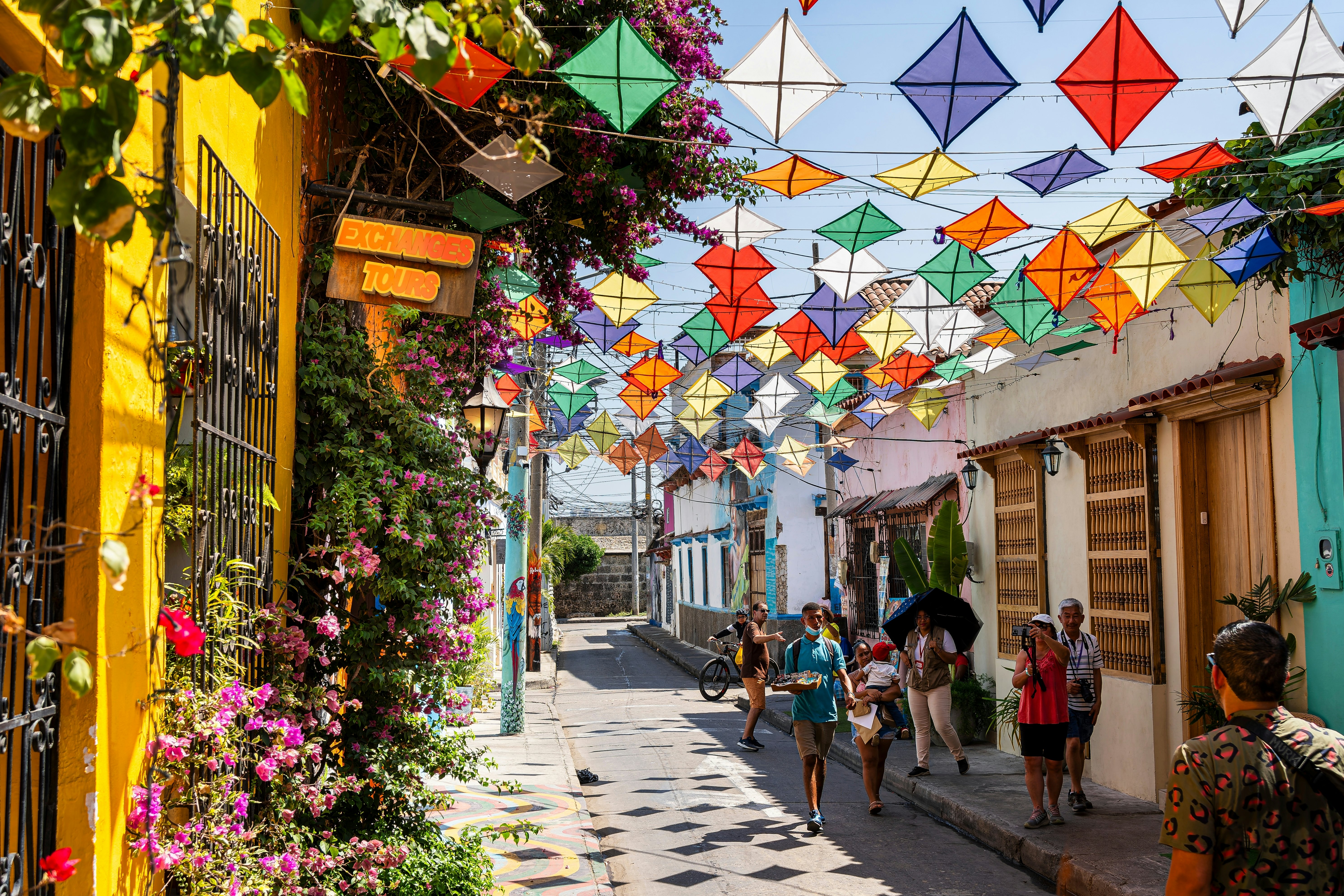

Find your way around in Cartagena with this guide to the city’s transport options. Shutterstock
Cartagena is one of Colombia’s easiest cities to navigate.
The well-preserved historic center and neighboring barrios invite exploration on foot, leading you through the picturesque streets, hidden alleys and captivating plazas. Should you desire a swifter pace, though, an array of transportation options are readily available to whisk you away, including taxis, buses and Uber or other ride-hailing apps.
Here’s the scoop on all the safe, affordable and quick ways to get around Cartagena.

Cartagena’s historic core is best explored on foot
Walking is one of the best ways to get to know Cartagena’s historic center, a pedestrian-friendly paradise separated from the rest of the modern city by a thick stone wall that dates to the 16th century. The Old Town is so compact it would take only 20 minutes to traverse by foot – yet it’s so filled with alluring attractions that you can spend days wandering its alleys. In fact, most of Cartagena’s top sites can be found either here or just outside Las Murallas (the wall).
Just east of the Old Town’s Torre del Reloj, neighboring Getsemaní is just as walkable. Traditionally an enclave of the working class, the barrio has in recent years transformed into a trendy district full of boutique hotels, restaurants and cafes. At every turn, the streets and narrow alleyways unveil colorful murals or flags, kites, umbrellas and lights strung overhead.
Tips for walking around Cartagena: Head out early in the morning or late in the afternoon to avoid the searing heat of the midday sun. If you don’t have a hat or drinking water, you’ll find plenty of vendors selling both. Though Cartagena is one of the safest cities to visit in Colombia, crime can occur. Keep your valuables hidden from view and opt for a taxi late at night.

Get around quicker by hailing a taxi
Taxis are the easiest and quickest way to get around Cartagena. Unlike in other big Colombian cities, you can feel safe hailing an official taxi on the streets here. (When in doubt, have someone at a hotel or restaurant summon one for you.) Official taxis are yellow, with the words “servicio publico” on their exterior, and the license plate number affixed to the side passenger door. It helps to have good negotiation skills as there are no meters. When you hail a taxi, agree on the price before getting in. If you’re not happy with what the driver wants to charge, stop engaging and simply wait for another taxi.
There are official prices for taxi fares, set by legal decree. As of March 2024, the minimum fare for travel around the historic center is COP$9800 ($2.25), while a taxi from the airport to hotels in the Old Town is COP$16100 ($3.70). Additional fees are levied for rides late at night. A tip is not expected, but rounding up to the nearest thousand pesos is good practice.
Tip for paying the right price for a taxi from Cartagena’s airport: At Cartagena’s Rafael Núñez International Airport (CTG), there is a kiosk just outside of customs that generates the correct taxi fare for your destination within the city. Go outside to the designated taxi stand to catch a ride, then hand the receipt to the driver with your fare when your ride ends – and feel relief about not getting overcharged.
Rideshare apps are safe and reliable in Cartagena
Uber can be used in major Colombian cities, including Cartagena – and it’s only one of many app-based services that get you from point A to B. Cabify (which acquired Easy Taxi and Easy Tappsi), InDriver and DiDi Rider are popular with Colombians because the fares tend to be a bit lower. Regardless of preference, these ride-hailing apps’ added security features – including the ability to share the driver’s name, vehicle type and license plate number, plus your real-time location, with someone you know – make them very popular with Cartageneros.
Get everywhere you need to go with rapid buses
Cartagena’s modern bus system consists of four main routes and a series of feeder lines. TransCaribe is a bus rapid transit (BRT) network, whose orange-and-white buses use dedicated lanes to serve designated routes throughout the city. The buses, which operate on clean-burning compressed natural gas, circulate from 6am to 11pm Monday through Friday, and weekends until 9pm.
Each ride costs COP$3000 ($.70), but no cash is accepted. You must have a rechargeable TuLlave card that can be purchased at TransCaribe stations for COP$6000 ($1.40). Top up the card at most stations or other authorized vendors, such as Giros Colombia.
Sample routes include the T102, which runs frequently from just outside of the airport, at Calle 70 and Carrera 4, into the city. The T103 skirts the Old Town on its way to Bocagrande and Castillogrande. From the Terminal de Transportes bus station, the X104 heads to the city center.
Tip for taking the bus around Cartagena: The free mobile-phone app Moovit provides route information and timetables.
Hop on a sightseeing bus for an overview of the city
Like other cities around the globe, Cartagena has its own hop-on, hop-off double-decker bus service. City Sightseeing’s red open-air bus cruises past 14 different tourist sites during its 90-minute loop around the historic center, and the Bocagrande, Castillogrande, Getsemaní and Manga neighborhoods. Tours depart every 45 minutes from the Muelle de Bodeguita. An all-day adult ticket costs US$19 – yet the two-day pass for US$54 is a great value, as it includes entrance to the massive Castillo de San Felipe de Barajas fortress, as well as a sunset catamaran cruise (an unmissable Cartagena experience).
While these fares are far higher than those for public transportation, such guided tours offer an easy way to crisscross the city and learn as you go – especially if you're traveling with small children. Kids ages 4 and under ride the bus for free.

Hop on a boat to see the city from the water, and visit nearby islands
A boat is the only way to reach several places near Cartagena, and a boat ride is a key component of a memorable day trip. On the waterfront near the Old Town’s Torre del Reloj (clock tower), the historic port of Muelle de la Bodeguita is where you’ll find boats to such destinations as the Islas del Rosario, Playa Blanca and the Islas de San Bernardo. Bypass all the vendors trying to sell package tours and go directly to the official window to pay for tickets. Boats leaves in the morning between 8 and 10am and return in the afternoon between 1 and 3pm.
If you plan on visiting Tierra Bomba, the closest island to the city, boats depart from the Castillogrande neighborhood. Take a taxi or bus R28 to Playa El Laguito next to the Hospital de Bocagrande. On the beach, you’ll find lanchas offering transportation to Tierra Bomba. Unless you’ve already reserved transportation through a particular beach club, you’ll have to put your negotiating skills to the test before agreeing on a price for roundtrip transportation, which should be around COP$20000 ($4.50). Settle up on the return trip.
Tip for taking a boat in Cartagena: The high winds from January to March can make long boat rides uncomfortable and wet, especially in the late afternoon. Store electronics and other valuables in a dry bag.

Rent a car only if you’re planning to venture beyond Cartagena
Getting around Cartagena is easy and affordable using public transportation and your own two feet. Yet if you insist on driving or want to explore the surrounding area, the airport is the most convenient place to rent a car, with most major rental companies on site.
As long as the driver’s license in your home country uses the Roman alphabet, an international driver’s license is not required. You will need your passport and a credit card to secure a vehicle.
Driving in Cartagena and elsewhere in Colombia often feels hectic, especially with the incredible number of motorcycles weaving in and out of traffic in urban areas. Drive with caution and avoid traveling after dark since obstacles – such as pedestrians, bicycles and animals – are harder to spot. When parking, find a secure parqueadero (parking lot) and take your valuables with you.
Tips for driving in Colombian cities, including Cartagena: Larger cities in Colombia have a driving- restriction scheme called Pico y Placa, which is designed to relieve traffic gridlock in large urban areas. Vehicles can only operate on certain days and times of the week, depending on the last number of their license plates. When renting a car, request a vehicle with a license-plate number that doesn’t interfere with your travel plans. Electric and hybrid vehicles are exempt.
Cartagena transportation FAQs and things to consider

Is it safe to walk around Cartagena?
Cartagena is one of the safest cities in Colombia. The Old Town, Getsemaní, Bocagrande and Castillogrande neighborhoods are regularly patrolled by police. That said, petty theft is still a possibility. Keep valuables out of sight and your wits about you. After dark, you might want to hail a taxi.
Are taxis safe in Cartagena?
Unlike other cities in Colombia, you can safely hail a taxi on the street in Cartagena. Licensed taxis are yellow and have “servicio publico” printed on the door. If you’re unsure, a hotel or restaurant can call one to pick you up. Remember to always negotiate the price up front before accepting the ride.
Should I rent a car in Cartagena?
If you’re sticking just to the city of Cartagena, renting a car is not worth the hassle. The Old Town has narrow streets and parking can be hard to find.
Is Uber illegal in Cartagena?
While ride-hailing apps, particularly Uber, have come under fire in Colombia from special-interest groups representing traditional taxi services, there is no specific law that makes them illegal. Uber was briefly banned from operating in Colombia after a high court decided in 2020 the company had violated competition rules. Within three weeks, Uber was back in business after discovering a legal loophole that allows its customers to rent a vehicle with a driver. However, transit police have pulled over drivers they suspect of not having a special license or a medallion called a cupo that allows them to operate as a taxi driver.
Given that licensing can cost up to US$50,000, it’s not surprising that most rideshare drivers don’t go through official channels. As a result, on-demand drivers risk sanctions that include fines and confiscation of their vehicles. Because of this, you may sometimes be asked to sit in the front seat to avoid drawing the attention of authorities.
Accessible transportation in Cartagena
From narrow or uneven sidewalks and steep curbs to buildings without ramps or elevators, getting around Cartagena is challenging for travelers with mobility issues. Newer TransCaribe buses are equipped with ramps, turnstiles and seating areas that accommodate wheelchair users. There’s often a gap between the platform and the entry doors, so a portable ramp is recommended. Some taxis can accommodate folding wheelchairs, but users of motorized wheelchairs will need private transportation.
















